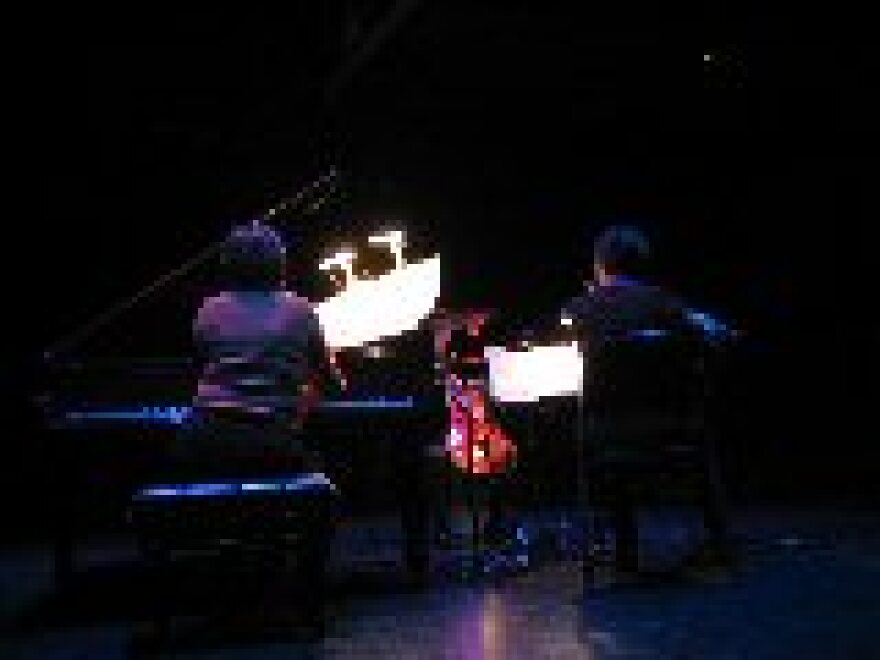For anyone who ever tried hiding army men in the family piano as a kid... or figured out how to make ghost noises on the flute... This weekend the Chamber Music Society of Wilmington is playing your song. In a program designed around environmental themes, one piece stands out with a musical vocabulary all its own. WHQR's Megan Williams has more...By Megan V. Williams
http://stream.publicbroadcasting.net/production/mp3/national/local-national-502564.mp3
Wilmington, NC, March 8, 2006 – Imagine the booming calls of the humpback whale; you've probably heard them on a relaxation tape somewhere, right? And then listen as out of them comes a strange, sliding, metallic echo. It's the cry of a chisel, running along a piano string. In the distance between those two sounds, is the entire art of composer George Crumb.
Crumb describes the whale song in musical terms: "it goes to the deepest pedal tones of an organ if you can imagine, up to really supersonic sounds that pass out of hearing. So the register is enormous and that's reflected in the music."
Crumb first heard a tape of whale songs thirty-five years ago. It was making the rounds of the New York music scene, turning composers on to the idea of directly incorporating nature into their work. Crumb headed in a different direction, struggling to unlock that same song, and the underwater universe that created it, from a trio of old-fashioned instruments - the piano, flute, and cello. The result was Voice of the Whale.
At seventy-six, Crumb has lived through more eras of modern music than most of us could name, and belonged to none of them. Instead, he's tended to range on the frontiers of instrumentation, stretching the limits of his instruments for the love of sound itself. One area it quickly led him to was amplification. So many of his techniques, Crumb says, were so delicate, "it needed a little amplification to project them to an audience."
Those techniques, including a passage in Voice of the Whale when the flute becomes a percussion instrument - you can hear the slaping of the keys louder than the player's breathing, are called 'extended,' or 'extra-musical,' effects are Crumb's signature... They're all the other sounds he's figured out how to make with an instrument - like asking the flutist to sing, or having the pianist hold an unfolded paperclip against the strings as she plays. At a performance this weekend in Wilmington, The Chamber Music Society's Barbara McKenzie will wield the paperclip.
The piece has forced her into an odd role behind the piano - that of choreographer. Throughout the work, the pianist stands to reach into the piano strings, sit down to play the keys, stand up again... "It's very interesting," McKenzie laughs, "because it keeps me busy. I have to have strong hamstrings for this piece, you don't usually think of that as a pianist."
As Artistic Director, McKenzie made Voice of the Whale part of the Chamber Music Society's inaugural season in 1997. She says although other contemporary composers such as John Cage also worked with extra-musical techniques. For them it was a question of pushing limits, "but for Crumb, it's really, how do I create this sound quality, how do I enhance this character, or this mood. So he's going a lot farther with it, it's not just about the technique. The technique serves the function of the expression in the music."
McKenzie developed the concert's entire program around the aquatic and environmental themes in Voice of the Whale. Contemporary compositions are often a hard sell with audiences more used to the familiar melodies of Beethoven and Bach. But one thing Voice of the Whale has on its side, many of its advocates say, is a strong 'program' - that is to say, it's about something. Its strange sounds represent something concrete.
For Chamber Music Society board member Delilah Elsen, that makes a big difference when listening to a new piece. She tells the story being given a piece of music to listen to by a composer. The untitled piece quickly lost her - without a subject it had no relevance to her, and became "a little far out there."
"So I was thinking, the fact that this piece has such a strong title, and it's relevant, and once you understand that concept, I think the mind, and the ear, is much better able to receive new tones, and new music, because it's within a context."
For all of his inventiveness, composer George Crumb readily admits he's always drawn from the other musical influences swirling around him. In more than half a century of composition, he's boiled it down into a unique style. The difficult part is bringing those disparate influences together for the audience. "That's my problem as a composer," he says, "is to make these things, try to make these things work within a style and to make a form and so forth."
Crumb's instrumental innovations have become part of the twentieth century's musical vocabulary, one that now includes vocalized flutes, prepare pianos, and the voice of the whale.
Megan Williams, WHQR News.

